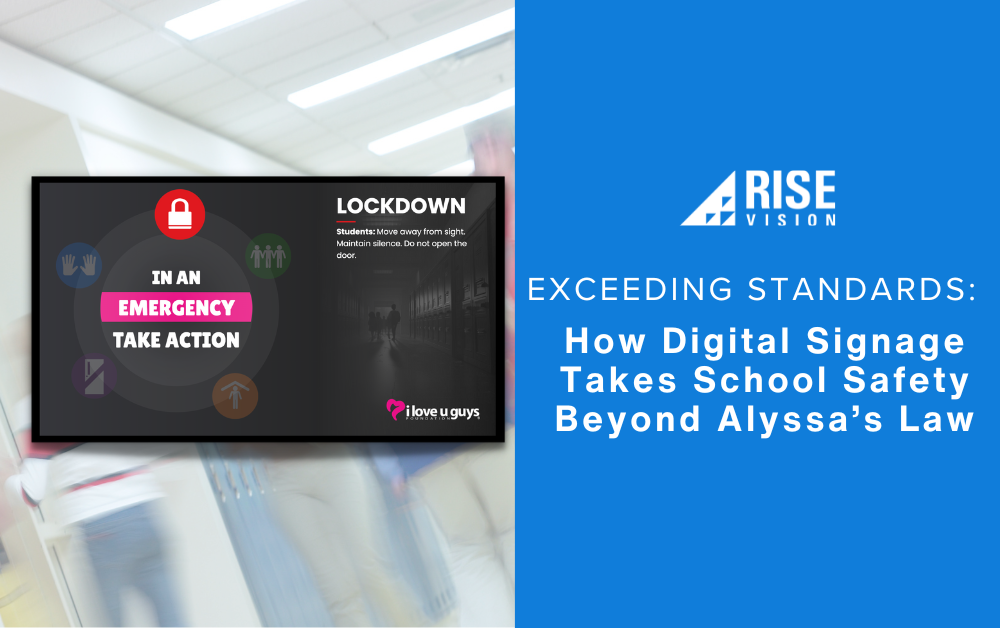
In the wake of heartbreaking school tragedies, the importance of robust security systems in schools cannot be overstated. Alyssa’s Law is a significant legislative response aimed at enhancing school safety. The exact wording of the law varies from state to state where it’s implemented, but generally, Alyssa's Law is aimed at enhancing school safety by mandating that all schools have implemented direct-to-first responder panic alert systems.
Let’s explore how digital signage software can help meet aspects of Alyssa’s Law that require silent text and visual alerts, and improve response times to emergencies.
A compelling example of this is from Necedah Schools, where the integration of digital signage with an emergency alert platform successfully reduced the school's lockdown time by 50%.
What is Alyssa's Law?
Alyssa’s Law is named after Alyssa Alhadeff, who tragically lost her life during the 2018 shooting at Marjory Stoneman Douglas High School in Parkland, Florida. This law requires public and charter schools to have silent panic alert systems that are directly linked to local law enforcement and first responder teams. The primary aim is to reduce response times during emergencies, potentially saving lives by improving communication channels during critical incidents.
Which States Have Passed Alyssa’s Law?
Alyssa’s Law has been adopted in several states, reflecting a growing recognition of the need for proactive safety measures in schools. The states that have passed this law include:
- Texas
- New York
- New Jersey
- Florida
- Tennessee
- Utah
Each state implements the law with specifics tailored to their local requirements and existing emergency response frameworks.
States across the country are considering Alyssa’s Law. Lawmakers in Arizona, Georgia, Massachusetts, Michigan, Nebraska, Oklahoma, Oregon, Pennsylvania, and Virginia have introduced Alyssa’s Law for consideration.
Alyssa’s Law Software Requirements
Under Alyssa’s Law, schools must implement a system that allows for immediate notification of local emergency services through a silent panic alert system. This system must be capable of:
- Initiating a silent alert that is sent directly to first responders and law enforcement agencies.
- Providing detailed and situation-specific notifications to the necessary personnel quickly and efficiently.
- Being accessible through various devices, including mobile and desktop platforms, ensuring widespread usability across school campuses.
The Role of Rise Vision Digital Signage Software in Complying with Alyssa’s Law
Digital signage can play a role in complying with Alyssa’s Law and enhancing your district's emergency response plan. Here’s how:
- Integration with CAP Alerts and Emergency Alert Providers: Advanced digital signage systems like Rise Vision can integrate seamlessly with Common Alerting Protocol (CAP) alerts and various emergency alert providers. This integration facilitates the broadcast of real-time, critical information throughout a school campus. In an emergency, TV displays and classroom interactive flat panels can display live updates, instructions, and alerts that guide both students and staff to safety.

- Expanding the Reach of Alerts: In the event of an emergency, it’s crucial that alerts reach every corner of the campus. Digital signage placed strategically around schools can display instant alerts simultaneously, ensuring no area is left uninformed. This is particularly useful in large schools where traditional communication might not reach everyone effectively.
- Visual and Audible Notifications: Unlike other forms of communication that might go unnoticed, digital signage captures attention visually in addition to the audible alarms. This ensures that during high-stress situations, where students and staff might not be checking phones or computers, the alert is still prominently displayed and impossible to miss.
- Enhanced Accessibility for All Students: Digital signage is particularly beneficial for increasing accessibility, especially for students with hearing impairments or those wearing headphones. Visual alerts ensure that important safety information is accessible to everyone, regardless of auditory impairments. According to the National Association of the Deaf, approximately 308,648 students with hearing impairments are enrolled in the public school system in the USA. The visual nature of digital signage means these students are not left out during critical emergencies, making it an essential tool in inclusive safety planning.
Watch Lisa York, Special Education Teacher, from Saline Area Schools talk about how her school enhanced accessibility for hearing impaired students.
- Customizable Content for Specific Emergencies: Digital signage software allows for the customization of content based on the specific nature of the emergency—whether it’s a lockdown, evacuation, or a weather-related event. Tailored messages can provide specific instructions that are crucial during the first moments of an incident.
- Testing and Drills: Regular drills are essential in preparing for emergencies. Digital signage can be used during these drills to simulate real emergency alerts, helping to educate and prepare both students and staff on proper procedures and routes, which can be crucial in actual emergency situations.
Real-World Applications: Texas Schools Enhancing Safety with Digital Signage
In response to Alyssa's Law in Texas, schools have been taking proactive measures to improve their security systems and emergency responsiveness. Digital signage serves as a pivotal component in these safety initiatives, offering an effective and immediate way to communicate during crises.
These two case studies from Texas highlight how digital signage integrated with emergency alert providers is bolstering school safety protocols, demonstrating tangible benefits and impacts.
Merkel ISD is Enhancing School Safety with CrisisGo Integration
Merkel ISD seamlessly integrated Rise Vision digital signage with CrisisGo and its Safety iResponse, a leading-edge safety solution designed to enhance emergency preparedness and response across educational campuses. This integration enables real-time emergency alerts to be displayed on digital signage across all campuses, and has revolutionized the district's emergency response protocols, providing timely information and enhanced overall school safety.
-> Read the Merkel ISD case study here.
Burkburnett CISD Integrates Digital Signage with Centegix
In alignment with Alyssa’s Law in Texas, Burkburnett CISD has successfully integrated their digital signage system with the Centegix crisis alert system. This integration ensures that during an emergency, critical alerts and messages are instantly displayed across digital signs throughout the campus. Rise Vision works seamlessly with Centegix to enhance the district’s ability to communicate quickly and effectively during crises, ensuring both staff and students are informed and can respond appropriately..
-> Read the Burkburnett case study here.
Beyond Alyssa’s Law: Wisconsin School Reduced Time to Lockdown by 50% with Digital Signage
.png?width=500&height=500&name=Kris%20Saylor%20(2).png)
To further demonstrate the versatility and effectiveness of digital signage in enhancing school safety, the experience of Necedah Schools in central Wisconsin offers valuable insights. Faced with the challenge of updating its communication infrastructure to provide both routine information and urgent alerts effectively, Necedah Schools turned to digital signage as a solution. This case study details how the integration of Rise Vision with Singlewire's InformaCast software played a pivotal role in transforming the school's communication and safety protocols.
Read How Necedah Schools Reduced the Time to Lockdown by 50% with Rise Vision and Singlewire
Leverage Digital Signage for School Safety
Digital signage software is not just a tool for everyday communication within schools. It’s a vital component of a school's safety strategy, particularly in states adhering to Alyssa’s Law. By implementing Rise Vision digital signage, schools can ensure they not only comply with legal requirements but also provide a safe and responsive environment for their students and staff. This proactive approach to school safety is essential in today’s world, where preparedness can make all the difference.
Interested in how your school can use Rise Vision to enhance safety? Book a free demo today.





